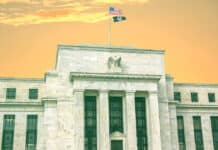
Among the notable aspects of the April market shakeout was a sell‑off in longer‑term U.S. Treasuries. My concern is that this may be only the first leg of an inevitable violent bear steepening in the Treasury yield curve. Higher Treasury yields has been a foundational view of mine for a while now, as I expressed last December in “The calm before the storm: The outlook for Treasury yields.” Circumstances and factors driving the Treasury market are now all starting to align to likely bring this view to fruition.
At the heart of my thesis has been a worry about a tsunami of global debt issuance, which is a legacy of COVID‑generated fiscal largesse. To be clear, this is not just a U.S. issue. The U.S. is merely another participant in a hugely crowded, bare‑knuckle global debt‑sale fight—and I don’t expect issuers to fight fair.
Another very important factor supporting higher Treasury yields is that even after the early April sell‑off, the 10‑year U.S. Treasury note offered essentially the same yield as cash in late April.1
Global growth should hold up amid fiscal stimulus from Europe and China
The tariff news of the last few weeks has only exacerbated the ongoing tug‑of‑war between inflation and growth worries in the rates market. I generally try to avoid broad, clichéd labels that are sometimes used arbitrarily, such as stagflation or recession. Indeed, I don’t have a particularly differentiated or downbeat perspective on growth. I am certainly not ready to slip into the doom loop dominating prevailing consensus. However, it does seem very clear to me that inflation risks are skewed severely to the upside.
On growth, in any normal environment, it would be really hard to be bearish about global growth when you have Europe and China both fiscally stimulating and easing monetary policy. While it seems like a lifetime ago, it was only in March that we saw a once‑in‑a‑generation fiscal expansion from Germany.
Also read: Trump vs The Fed – What’s Next?
I also try to keep reminding myself that the U.S. is largely a service‑based economy that relies mostly on domestic demand. In addition, further U.S. fiscal stimulus is also imminent as we head into the summer. Therefore, I think the most accurate way to think about growth is that the range of outcomes has simply widened. In short, I am not jumping into the recession camp without seeing further evidence.
But inflation expectations could easily become unanchored
Regarding inflation, I don’t think we can underestimate the game‑changing nature of 2022, which transformed both company and consumer attitudes and expectations around inflation. After being burned by inflation that proved far from transitory in 2022, it will be very easy for consumer inflation expectations to become unanchored.
What we hear from current meetings with CEOs and CFOs of companies across industries and around the globe is an almost universal willingness to proactively pass on tariffs and other frictional costs to their customers. As one of my T. Rowe Price colleagues said, we are in the midst of a supply shock with the potential for a demand shock on the horizon. With this backdrop, inflation may present another challenge to U.S. Treasuries.
There is one major factor that argues against inflation right now—the fall in energy prices. To be clear, this isn’t because U.S. domestic production has increased. Instead, it is due to the somewhat puzzling, opaque political decision from OPEC+ to increase oil production. One thing that is clear from our analysis is that at current oil prices around USD 66 per barrel for Brent crude,2 Saudi Arabia’s budget deficit will likely worsen. Is that sustainable? If it is, it will need to be funded by—you guessed it—lots more debt issuance.
Watch for fiscal expansion to be the next overriding market theme
One campaign agenda item that the Trump administration has yet to fully engage with is tax cuts. The odds of a large fiscal package passing before the U.S. Congress leaves for its summer recess are growing. I anticipate that fiscal expansion will soon become the next overriding focus for markets.
Fiscal expansion may be growth supportive, but most importantly it would likely put even more pressure on the Treasury market. I am now even more convinced that the 10‑year U.S. Treasury yield will reach 6% in the next 12–18 months. Almost every piece of news this year has reenforced this view. In particular, higher inflation and further global fiscal expansion are a toxic combination for rates, particularly U.S. Treasuries. Higher yields and steeper curves are likely coming.
How to respond: Inexpensive inflation protection
Inflation protection remains cheap. With five‑year inflation breakevens around 2.36% in late April,3 exposure to Treasury inflation protected securities (TIPS) instead of nominal Treasuries looked like an attractive inflation hedge. This position should benefit if annual U.S. consumer price inflation averages 2.36% or more over the next five years, which seems likely as the supply shock of tariffs pushes prices higher.
I am also struck by two other observations. First, I am very happy that I am engaged in managing extremely liquid assets. The dislocations and opportunities being presented by the recent market volatility have been phenomenal. As I mentioned above, the range of potential outcomes has widened substantially. Not having the liquidity to react to those outcomes would be limiting.
Second, return correlations between different assets and asset classes have changed very quickly, in some cases flipping from positive to negative or vice versa. These correlations—whether between fixed income, currencies, and equities, or indeed between individual bonds, currencies, or stocks—are one of the most important factors in portfolio construction. Taking a view on future asset class correlations may prove to be far more important in portfolio outcomes than an outlook on individual assets.
[1] On April 25, 2025 the 10‑year U.S. Treasury yield was 4.27% and the 4‑week Treasury bill yield was 4.28%. Source: Bloomberg Finance LP.
[2] Current pricing source: Bloomberg Finance LP.
[3] Source: Bloomberg Finance LP.

































